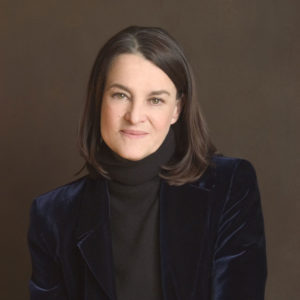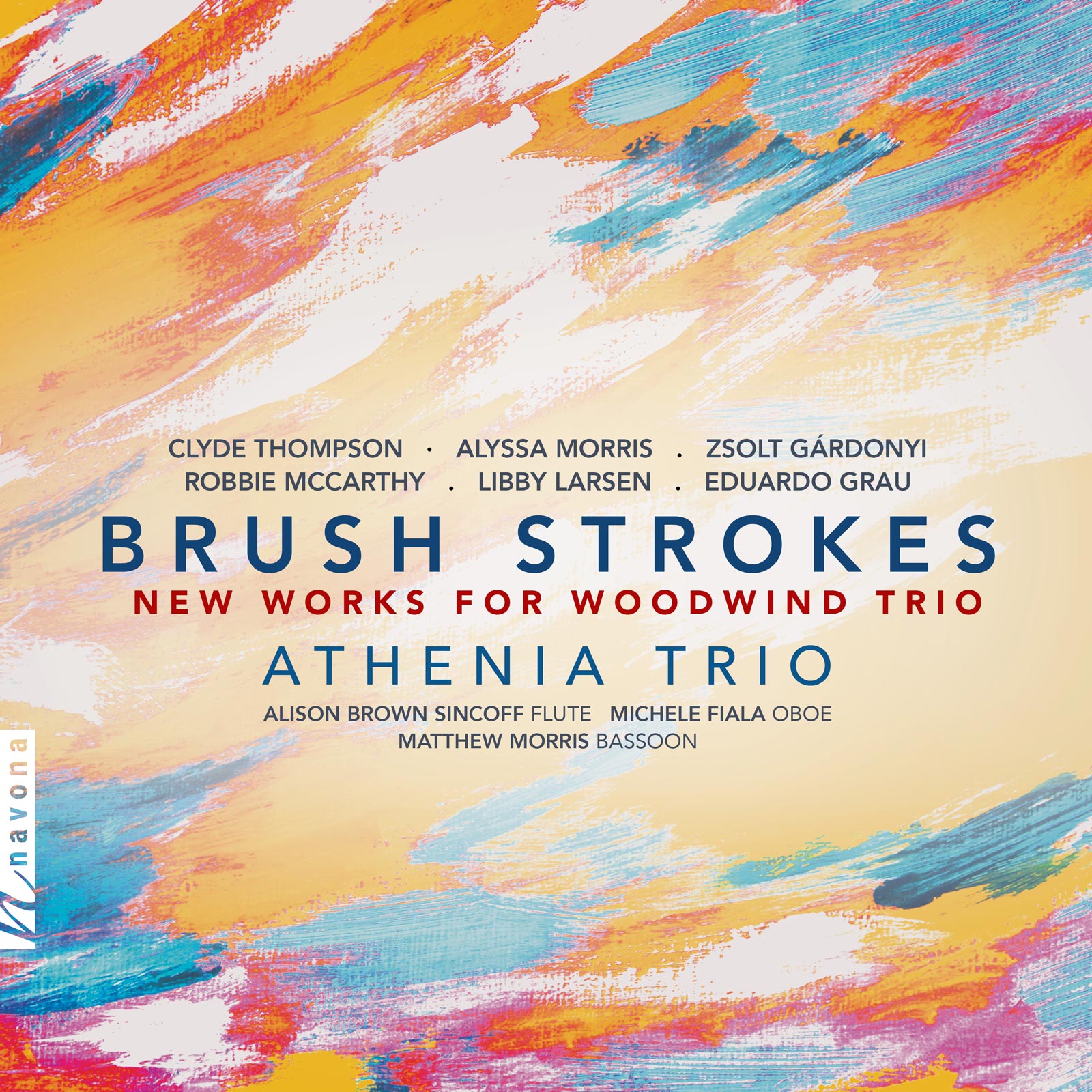Brush Strokes
Clyde Thompson composer
Alyssa Morris composer
Zsolt Gárdonyi composer
Robbie McCarthy composer
Libby Larsen composer
Eduardo Grau composer
Athenia Trio | Alison Brown Sincoff, flute; Michele Fiala, oboe; Matthew Morris, bassoon
BRUSH STROKES from Athenia Trio features works for flute, oboe, and bassoon. The program harnesses the impressive versatility of the trio, with six pieces by six different composers, including two commissioned specially for the ensemble: Alyssa Morris’s Brush Strokes, and Robbie McCarthy's The Blind Men and the Elephant.
Morris’s piece is a multimedia work of sorts, reimagining much-loved paintings by artists like Seurat, Monet, and Van Gogh; the three instruments of the Athenia Trio become the “brushes”; McCarthy's piece is a six-movement work with spoken word based on the parable of the blind men and the elephant. Trio de la fiesta mayor, composed by Eduardo Grau in 1953, recalls the festival music heard in Spanish villages. The music is grounded in Latin-American tradition. From one piece to the next, listeners will be surprised and delighted by what they hear on BRUSH STROKES.
Listen
"The Athenias play so very well together, and convey strongly their sheer pleasure in the music"
Track Listing & Credits
| # | Title | Composer | Performer | |
|---|---|---|---|---|
| 01 | 4 Miniatures: No. 1, Con brio | Clyde Thompson (B. 1947) | Athenia Trio | Alison Brown Sincoff, flute; Michele Fiala, oboe; Matthew Morris, bassoon | 1:09 |
| 02 | 4 Miniatures: No. 2, Espressivo | Clyde Thompson (B. 1947) | Athenia Trio | Alison Brown Sincoff, flute; Michele Fiala, oboe; Matthew Morris, bassoon | 1:27 |
| 03 | 4 Miniatures: No. 3, Semplice | Clyde Thompson (B. 1947) | Athenia Trio | Alison Brown Sincoff, flute; Michele Fiala, oboe; Matthew Morris, bassoon | 1:13 |
| 04 | 4 Miniatures: No. 4, Presto | Clyde Thompson (B. 1947) | Athenia Trio | Alison Brown Sincoff, flute; Michele Fiala, oboe; Matthew Morris, bassoon | 2:40 |
| 05 | Brush Strokes: I. Monet | Alyssa Morris (B. 1984) | Athenia Trio | Alison Brown Sincoff, flute; Michele Fiala, oboe; Matthew Morris, bassoon | 2:30 |
| 06 | Brush Strokes: II. Seurat | Alyssa Morris (B. 1984) | Athenia Trio | Alison Brown Sincoff, flute; Michele Fiala, oboe; Matthew Morris, bassoon | 2:07 |
| 07 | Brush Strokes: III. Van Gogh | Alyssa Morris (B. 1984) | Athenia Trio | Alison Brown Sincoff, flute; Michele Fiala, oboe; Matthew Morris, bassoon | 3:41 |
| 08 | Brush Strokes: IV. Pollock | Alyssa Morris (B. 1984) | Athenia Trio | Alison Brown Sincoff, flute; Michele Fiala, oboe; Matthew Morris, bassoon | 2:40 |
| 09 | 3 Rondos: No. 1, Allegretto | Zsolt Gárdonyi (B. 1946) | Athenia Trio | Alison Brown Sincoff, flute; Michele Fiala, oboe; Matthew Morris, bassoon | 1:20 |
| 10 | 3 Rondos: No. 2, Lento | Zsolt Gárdonyi (B. 1946) | Athenia Trio | Alison Brown Sincoff, flute; Michele Fiala, oboe; Matthew Morris, bassoon | 2:30 |
| 11 | 3 Rondos: No. 3, Allegro | Zsolt Gárdonyi (B. 1946) | Athenia Trio | Alison Brown Sincoff, flute; Michele Fiala, oboe; Matthew Morris, bassoon | 1:09 |
| 12 | The Blind Men and the Elephant (Arr. for Narrator, Flute, Oboe & Bassoon): I. Wall | Robbie McCarthy (B. 1989) | Athenia Trio | Alison Brown Sincoff, flute; Michele Fiala, oboe; Matthew Morris, bassoon | 1:52 |
| 13 | The Blind Men and the Elephant (Arr. for Narrator, Flute, Oboe & Bassoon): II. Spear | Robbie McCarthy (B. 1989) | Athenia Trio | Alison Brown Sincoff, flute; Michele Fiala, oboe; Matthew Morris, bassoon | 2:23 |
| 14 | The Blind Men and the Elephant (Arr. for Narrator, Flute, Oboe & Bassoon): III. Snake | Robbie McCarthy (B. 1989) | Athenia Trio | Alison Brown Sincoff, flute; Michele Fiala, oboe; Matthew Morris, bassoon | 2:06 |
| 15 | The Blind Men and the Elephant (Arr. for Narrator, Flute, Oboe & Bassoon): IV. Tree | Robbie McCarthy (B. 1989) | Athenia Trio | Alison Brown Sincoff, flute; Michele Fiala, oboe; Matthew Morris, bassoon | 2:11 |
| 16 | The Blind Men and the Elephant (Arr. for Narrator, Flute, Oboe & Bassoon): V. Fan | Robbie McCarthy (B. 1989) | Athenia Trio | Alison Brown Sincoff, flute; Michele Fiala, oboe; Matthew Morris, bassoon | 1:45 |
| 17 | The Blind Men and the Elephant (Arr. for Narrator, Flute, Oboe & Bassoon): VI. Rope | Robbie McCarthy (B. 1989) | Athenia Trio | Alison Brown Sincoff, flute; Michele Fiala, oboe; Matthew Morris, bassoon | 2:30 |
| 18 | Impromptu (Version for Flute, Oboe & Bassoon) | Libby Larsen (B. 1950) | Athenia Trio | Alison Brown Sincoff, flute; Michele Fiala, oboe; Matthew Morris, bassoon | 2:46 |
| 19 | Trio de la fiesta mayor (Version for Flute, Oboe & Bassoon): I. Preludio | Eduardo Grau (1919-2006) | Athenia Trio | Alison Brown Sincoff, flute; Michele Fiala, oboe; Matthew Morris, bassoon | 1:12 |
| 20 | Trio de la fiesta mayor (Version for Flute, Oboe & Bassoon): II. Oración | Eduardo Grau (1919-2006) | Athenia Trio | Alison Brown Sincoff, flute; Michele Fiala, oboe; Matthew Morris, bassoon | 2:39 |
| 21 | Trio de la fiesta mayor (Version for Flute, Oboe & Bassoon): III. Tamboril | Eduardo Grau (1919-2006) | Athenia Trio | Alison Brown Sincoff, flute; Michele Fiala, oboe; Matthew Morris, bassoon | 1:29 |
| 22 | Trio de la fiesta mayor (Version for Flute, Oboe & Bassoon): IV. Procesión | Eduardo Grau (1919-2006) | Athenia Trio | Alison Brown Sincoff, flute; Michele Fiala, oboe; Matthew Morris, bassoon | 1:52 |
| 23 | Trio de la fiesta mayor (Version for Flute, Oboe & Bassoon): V. Sonata | Eduardo Grau (1919-2006) | Athenia Trio | Alison Brown Sincoff, flute; Michele Fiala, oboe; Matthew Morris, bassoon | 2:09 |
All tracks recorded March 30, April 19, 20, 28, May 1, 2, 10, and August 12, 19, 2019 at Ohio University School of Media Arts & Studies in Athens OH
Recording Session Engineer Jeff Redefer
Brush Strokes & The Blind Men and the Elephant Commissioned by the Athenia Trio with funds from the Ohio University College of Fine Arts Creative Research Award. This recording was funded by an Ohio University Baker Fund Award.
Executive Producer Bob Lord
Executive A&R Sam Renshaw
A&R Director Brandon MacNeil
A&R Danielle Lewis
VP, Audio Production Jeff LeRoy
Audio Director Lucas Paquette
Mastering Shaun Michaud
VP, Design & Marketing Brett Picknell
Art Director Ryan Harrison
Design Edward A. Fleming
Publicity Patrick Niland, Sara Warner
Artist Information

Libby Larsen
Libby Larsen (b. 24 December 1950, Wilmington, Delaware) is one of America’s most performed living composers. She has created a catalogue of over 400 works spanning virtually every genre from intimate vocal and chamber music to massive orchestral works and over twelve operas. Grammy Award winning and widely recorded, including over fifty CD’s of her work, she is constantly sought after for commissions and premieres by major artists, ensembles, and orchestras around the world, and has established a permanent place for her works in the concert repertory.

Athenia Trio
Athenia Trio presents multimedia, interactive performances that feature flute, oboe, and bassoon. Athenia is a faculty ensemble at Ohio University in Athens. Founding members Alison Brown Sincoff (flute), Michele Fiala (oboe), and Matthew Morris (bassoon) have collectively performed in the United States, Canada, Italy, Germany, England, France, Russia, Japan, Panama, and Argentina. The trio was formed in 2009 and has performed across the United States from coast to coast and in Italy.

